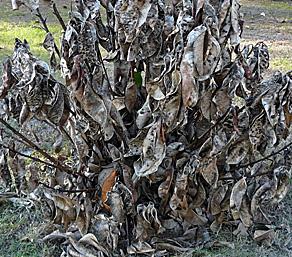Unused stories
Pest of the Month - Frost

The long period of cold nights has caused a lot of frost damage in our gardens. Here's how to safely and adequately protect your plants:
Keep watering. Thirsty plants are more susceptible to cold damage. Water your garden several days before frosty weather to create a "heat sink" that retains warmth. This protects roots and warms air near the soil. If no rain is in the forecast, turn on your drip system or sprinkle plants in the evening. Note: this strategy may backfire with some succulents, which have a better chance of survival if the soil around them is dry.
Cover up. It may be late for Halloween, but this time of year it's not unusual to see shrubs dressed up like ghosts. Those costumes help keep warmth in. The key here is to cover susceptible plants all the way down to the ground. Why? Because that's where the warmth is. Plants don't produce heat. Instead, they rely on the soil as their main source of warmth. Therefore, to adequately protect a sensitive plant, cover it with an old sheet or other protective cover and let it drape all the way to the ground where you can secure it with bricks or rocks. Uncover the next day to allow the sun to warm the soil surface. Repeat as needed.
Let there be light. Your Christmas tree need not be your only bedazzled greenery. To generate extra heat, place a 100-watt lamp designed for outdoor use in the center of a susceptible tree or string Christmas lights in the canopy. If practical and safe, cover to retain warmth. Do not use LED lights, which do not emit much heat, and be sure lights do not touch any foliage, bark or protective covering.
Spray on. Apply an antitranspirant such as Cloud Cover, available at your local nursery. Spray directly on foliage of cold-sensitive plants to seal in moisture. One application can provide up to three months of protection by coating leaves with an invisible polymer film.
Cut the clippers. Regardless of how awful the symptoms of freeze damage look, don't prune off damage foliage or branches until after the danger of frost has completely passed. That means through winter and into spring. Pruning too soon increases the risk of infection, and the unsightly plant material actually provides protection to areas lower on the plant.
Mulch. It's hard to overdo mulch, which helps regulate soil temperature and retain moisture. For short but biting frosts, you can even cover low-growing groundcovers entirely with lightweight mulch such as rice straw or leaf mold. Remove as soon as danger of frost has passed.
Cluster containers. Gather your planting containers together and place in a sheltered spot close to the house if possible.
Plan ahead. If you have a penchant for tender plants but live in a low-lying area that is a frost magnet, consider strategies that may provide some protection. Plant next to boulders, stone paths and south- or west-facing walls that absorb heat during the day and radiate it at night.
Edited from the original Marin Independent Article for the Master Gardener website by L. Jennings.
Click here for more information on how to protect plants from frost: http://ucanr.edu/sites/MarinMG/Marin_Master_Gardener_Help_Desk/Leaflet/How_to_protect_plants_from_frost/
